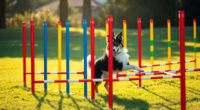To prepare your home for a puppy, start by puppy-proofing your space—secure cords, store chemicals safely, and remove small objects. Create a cozy, quiet resting area with a crate and comfy bedding. Gather essential supplies like food, bowls, toys, and grooming tools, and set clear house rules. Plan daily exercise and mental activities while introducing your puppy gradually to other pets and family members. Keep your home calm and organized, setting the stage for a smooth progression.
Key Takeaways
- Puppy-proof living spaces by removing hazards, securing cords, and storing chemicals safely.
- Create a quiet, comfortable resting area with crate training and cozy bedding.
- Gather essential supplies such as food, bowls, toys, grooming tools, and cleaning products.
- Establish household rules and boundaries with consistent training and positive reinforcement.
- Prepare the family for the puppy’s arrival by discussing routines, responsibilities, and socialization plans.
Puppy-Proofing Your Living Spaces

Before bringing your puppy home, it’s essential to make your living spaces safe and secure. Start by removing or securing items that could harm your puppy, such as cleaning supplies kept under sinks or in easily accessible cabinets. Store chemicals safely out of reach. Keep your puppy’s toys and chews in designated areas, ensuring they’re safe and free of small parts that could be swallowed. Remove electrical cords or cover outlets to prevent chewing and electrical shocks. Check for small objects on the floor that could be swallowed or cause choking. Remember, puppies are curious and will explore everything. By puppy-proofing early, you create a safe environment where your new furry friend can play, learn, and grow without unnecessary risks or hazards. Additionally, understanding safe pet environments can help you better prepare your home for a new puppy. Creating a designated safe space for your puppy to retreat to can also help reduce anxiety and promote healthy behavior. Proper supervision and puppy-proofing during playtime ensure your puppy remains protected from potential dangers and learns appropriate boundaries. Being aware of hazards in the home can further prevent accidents and injuries.
Gathering Essential Supplies

Once your living space is safe and puppy-proofed, it’s time to gather the supplies you’ll need to welcome your new furry friend. Start with puppy feeding essentials, such as a sturdy bowl for food and water, and high-quality puppy food suited to their age. You’ll also want grooming essentials like a gentle brush, puppy shampoo, and nail clippers to keep your pup clean and comfortable. Consider buying toys to stimulate their mind and help with teething, along with a leash and collar for walks. It’s helpful to have cleaning supplies, like enzymatic cleaners, on hand for accidents. Having these essentials ready guarantees your puppy feels secure and well-cared for from day one. Preparing now sets the stage for a smooth transition into your home. Essential oils for pet health can be useful in creating a calming environment for your new puppy. Additionally, understanding digital literacy programs can help you stay informed about safe and playful communication methods for your pet and family. A well-organized space with safety measures in place can further ensure your puppy’s safety and peace of mind for everyone involved. To further safeguard your home, it’s also beneficial to monitor payment processing systems if you plan to purchase supplies online, ensuring secure transactions and protecting your financial information.
Creating a Safe and Comfortable Resting Area
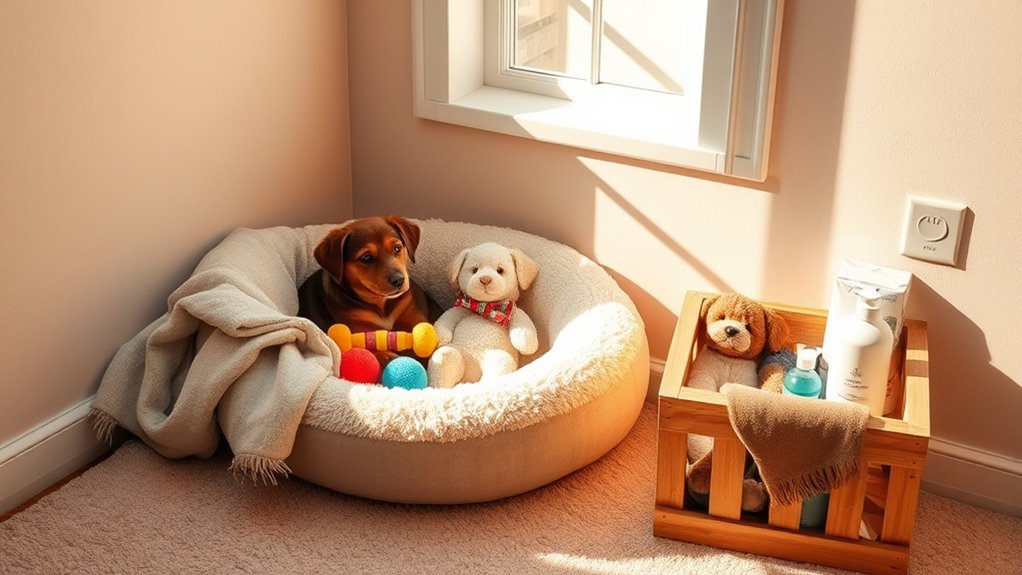
Creating a safe and comfortable resting area is essential for your puppy’s well-being and helps them feel secure in their new environment. Start by choosing a quiet, draft-free spot where your puppy can relax without disturbances. Incorporate crate training to establish a designated space that promotes safety and helps with housebreaking. Make sure the crate has comfortable bedding that’s soft, washable, and appropriately sized—allowing enough room for your puppy to turn around comfortably. Avoid placing the crate in busy areas or near loud appliances, which can cause stress. Consistently use this space for resting and sleeping, so your puppy associates it with comfort and security. A well-prepared resting area supports your puppy’s emotional health and makes the transition to your home smoother. Additionally, ensuring the safety of the environment by removing hazards helps create a more secure space for your puppy to rest peacefully. To promote overall well-being, consider providing mental stimulation within the resting area through gentle toys or scents to make it more inviting. Incorporating appropriate environment considerations such as lighting and temperature can also enhance your puppy’s comfort. Being mindful of vet recommendations can further help in creating an optimal resting space tailored to your puppy’s needs. Proper remote work practices can also help you stay attentive to your puppy’s needs during these adjustments.
Establishing Boundaries and House Rules
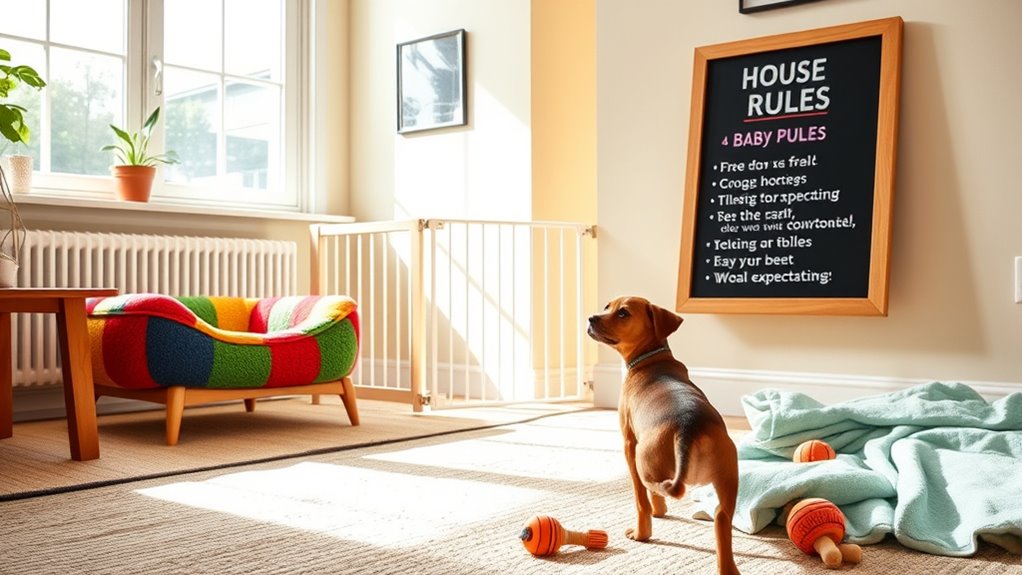
Establishing clear boundaries and house rules from the start helps your puppy understand what behaviors are expected and acceptable. Consistent training is key to reinforcing these rules, so everyone in your household should follow the same guidelines. Decide which areas are off-limits and be firm yet gentle in enforcing them. Crate training is an effective tool for establishing boundaries, helping your puppy learn that certain spaces are designated for rest and safety. Set rules about furniture, chewing, and bathroom habits early on, and stick to them. Consistency ensures your puppy doesn’t get confused or develop bad habits. Remember, clear boundaries and rules provide structure, making house training smoother and fostering a respectful, well-behaved companion. Additionally, understanding how a puppy’s behavioral traits are influenced by early training can help tailor your approach for better results. Creating a positive reinforcement environment will encourage your puppy to follow the rules happily. Recognizing and adapting to your puppy’s learning style can further enhance the training process and establish a stronger bond. Incorporating appropriate butter tips and tricks, such as using treats or toys as rewards, can make training sessions more effective and enjoyable. Consistent use of clear cues helps your puppy associate commands with behaviors, leading to faster learning and clearer communication.
Planning for Exercise and Mental Stimulation
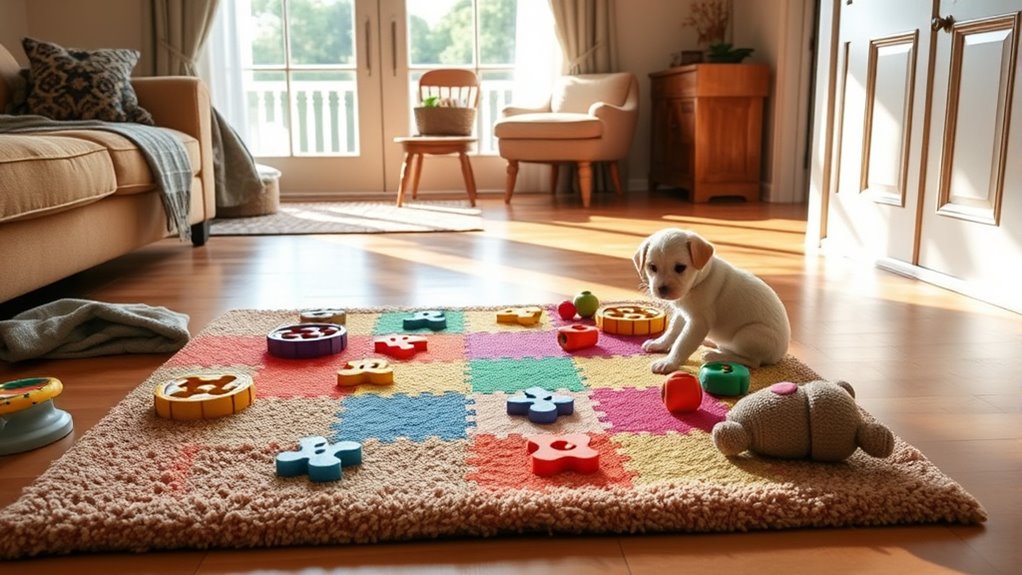
Because puppies have boundless energy and curiosity, planning for regular exercise and mental stimulation is essential for their well-being. Incorporate daily walks and playtime to help burn off energy and prevent destructive behaviors. Use interactive toys to keep your puppy mentally engaged, encouraging problem-solving and focus. Training sessions are also valuable—they reinforce good behavior and challenge your puppy’s mind. Short, frequent sessions work best, making learning enjoyable. Mix up activities to prevent boredom and ensure your puppy stays active both physically and mentally. Developing a training routine and engaging activities set the foundation for a healthy, balanced puppy. Additionally, introducing Mazda Tuning concepts such as performance upgrades can serve as a fun mental challenge for older puppies or adult dogs interested in “learning” new tricks, fostering their cognitive development. Building a variety of enrichment activities can further stimulate your puppy’s natural instincts and curiosity. Incorporating mental exercises like puzzle toys can also enhance their problem-solving skills and keep their mind sharp.
Preparing Your Family and Other Pets
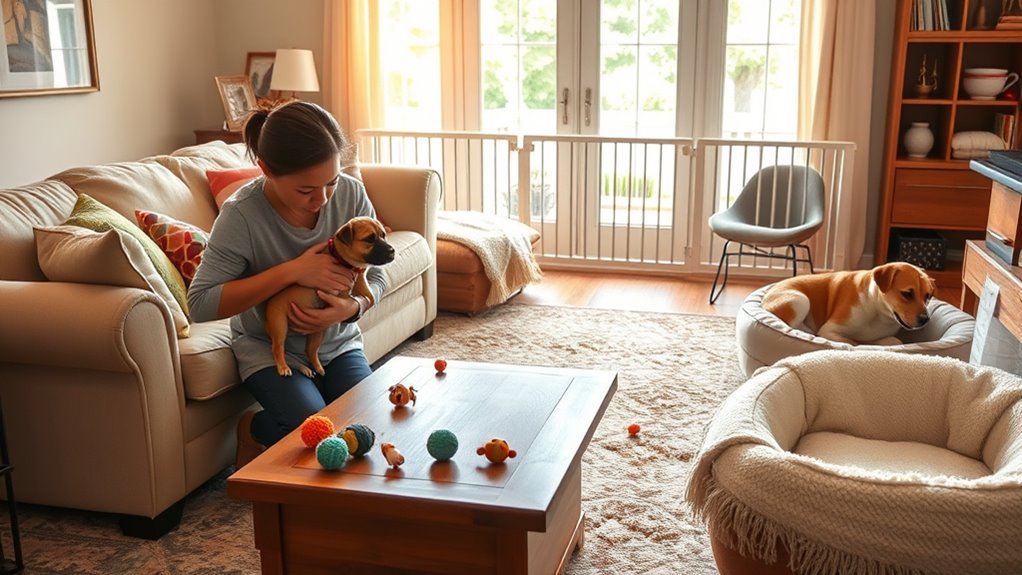
Preparing your family and other pets for a new puppy is essential to guarantee a smooth shift. Open family communication helps everyone understand the upcoming changes and sets expectations. Discuss the puppy’s needs, rules, and routines so each member feels involved and prepared. When introducing your new puppy to existing pets, use pet introduction techniques such as gradual exposure and controlled meetings. Keep initial interactions brief and positive, allowing your pets to get used to each other’s scents before face-to-face meetings. Reinforce calm behavior and provide plenty of praise. Ensuring all family members are on the same page reduces stress and fosters a welcoming environment for everyone—both human and furry—making the transition easier and more enjoyable for all. Incorporating trust-building strategies can also help establish a positive relationship between your pets and the new family member.
Frequently Asked Questions
How Can I Puppy-Proof an Apartment With Multiple Levels?
You can puppy-proof your multi-level apartment by ensuring furniture safety and installing stair barriers. Secure or block off furniture that could tip over or harm your puppy. Use stair barriers at the top and bottom of stairs to prevent falls. Keep cords, small objects, and toxic plants out of reach. Regularly check for hazards, and create a safe, puppy-friendly environment on each level to keep your new pup safe and happy.
What Are Budget-Friendly Ways to Gather Puppy Supplies?
They say “necessity is the mother of invention,” and that’s true when gathering puppy supplies on a budget. You can make DIY toys from old t-shirts or socks and bake homemade treats to save money. These options are not only affordable but also fun and customizable. Plus, you’ll enjoy bonding with your puppy while creating eco-friendly, budget-friendly essentials that keep your new furry friend happy and healthy.
How Do I Choose the Best Crate Size for My Puppy?
To choose the best crate size for your puppy, focus on crate training and puppy comfort. Pick a crate that’s just large enough for your puppy to stand, turn around, and lie down comfortably. Avoid oversized crates, as they can hinder crate training. As your puppy grows, gradually modify the size or switch to a larger crate to ensure ongoing comfort and effective training.
What Are Effective Methods to Introduce a New Puppy to Existing Pets?
Imagine opening a new chapter in your home’s story; a gentle dog introduction sets the tone. Introduce your puppy to existing pets gradually, using scent swapping and supervised meetings. Manage pet hierarchy by encouraging calm interactions and offering equal attention. Keep sessions short and positive, watching for signs of stress or dominance. This careful approach helps your pets build trust, fostering harmony and making the *shift* smooth for everyone involved.
How Can I Prepare My Family for the Responsibilities of Puppy Care?
You should focus on family communication to guarantee everyone understands their responsibilities with puppy care. Talk openly about feeding, training, and cleaning routines, and set clear expectations. Establish routines early so everyone knows what to do, reducing confusion. Involving the whole family in planning helps foster teamwork and consistency, making puppy care manageable and enjoyable for everyone. This way, your family stays united and prepared for the new arrival.
Conclusion
By preparing your home and setting gentle boundaries, you create a welcoming garden where your puppy can explore happily without getting into trouble. With patience and love as your guiding compass, you’ll watch your new friend blossom into a well-behaved and joyful companion. Remember, every careful step you take plants the seeds for a lifetime of happy memories together. Soon, your home will be a cozy nest filled with wagging tails and warm, wagging hearts.


